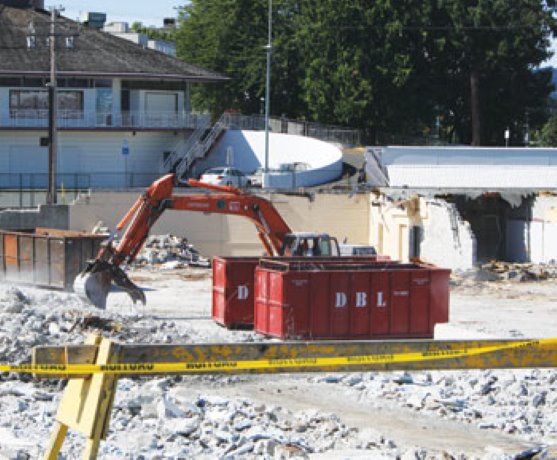A massive threat to worker safety is looming before the construction industry. Silica dust, which has been called the new asbestos, is starting to be recognized for taking its toll on worker’s health.
correspondent
A massive threat to worker safety is looming before the construction industry. Silica dust, which has been called the new asbestos, is starting to be recognized for taking its toll on worker's health.
WorkSafeBC has recently launched another awareness campaign focused on enforcing jobsite specifications around the control of airborne chemical contaminates, including silica dust.
Al Johnson, regional director for WorkSafeBC said the health and safety authority has increased its focus on occupational diseases. Statistics indicate that while the number of traumatic worksite fatalities has dropped, fatalities due to occupational disease are on the rise.
“Typically, as people are exposed to chemical substances, it can take a number of years to manifest,” he said.
“People exposed over a lifetime are dying in their 50s to 70s, which is why we are working at preventing exposures today.”
Between 2001 and 2010, the number of fatal claims accepted by WorkSafe- BC attributed to worksite trauma dropped from 43 percent to 29 percent. Fatal accidents, due to work related motor vehicle accidents, also dropped to 19 per cent from 22 per cent. The percentage of accepted fatal claims due to occupational disease rose from 32 percent in 2001 to 52 percent in 2010.
“We can’t do much for those exposed before, but we can help prevent future exposure,” Johnson said.
“We put out a notice this time last year for individuals to think about exposure and have the measures in place to show how workers can protect themselves and employees too.
“We are asking employers to take the regulations more seriously and apply the same responsibility in this area, as in the area of exposure to other dusts,” Johnson said.
Crystalline silica dust, commonly found in sand, rock and building materials, such as concrete and brick, is released into the air each time these materials are cut, ground or drilled.
Breathing the particles in concentrations higher than recommended exposure limits can result in permanent lung damage.
The exposure limit for respirable crystalline silica (including quartz) is 0.025 milligrams per cubic metre (mg/m3)—a concentration workers could be exposed to eight hours per day, five days per week, without adverse health affects, according to the occupational health and safety regulation.
As a suspected carcinogen, however, crystalline silica is considered an ALARA substance, meaning exposures must be reduced to levels As Low As Reasonably Achievable, below the recommended limit. Airborne silica mainly affects people working with rock, concrete, masonry, asphalt or heavy steel. Abrasive blasting, tile cutting, tuck point grinding, some structural demolition and clean-up, among other activities, can expose workers to unsafe levels.
Chronic silicosis develops after 10 or more years of exposure in relatively low doses.
Accelerated silicosis develops five to 10 years after initial exposure to crystalline silica at high concentrations. Acute silicosis can occur anywhere from a few weeks to four to five years after exposure to extremely high concentrations of the dust. Symptoms include shortness of breath, severe cough and weakness, and can become progressively worse.
It sometimes results in death. Under Section 5.54 (Exposure control plan) of Occupational Health and Safety Regulations, employers are required to develop an exposure control plan in any cases where employees may be exposed to airborne silica dust in excess of 50 per cent of the exposure limit.
According to the Yukon Workers’ Compensation Health and Safety Board worker exposure to crystalline silica and other air contaminants often goes unchecked because some companies lack organized respiratory protection programs or sufficient employee training. Some purchasers of construction are also making safety a priority.
“Any contractor engaged to perform work for VIHA (Vancouver Island Health Authority) is given a site safety orientation session that includes silica dust control and an overview of what dust control measures are expected pertaining to CSA Z317.13-07,” said Dean Anderson, director, facilities maintenance and operation for VIHA.
VIHA’s Silica Exposure Control Plan requires workers to wear a respirator to drill a single hole in concrete and during general clean-up.
Johnson said Wo r k S a f e BC’s campaign is asking employers to take the issue more seriously and overcome a dated culture in the industry that may not take safety equipment seriously.
“Ten years ago, no one wore a respirator, but today not so much,” he said.
“Now a respirator is a standard piece of equipment that anyone working with these substances should use. There are also vacuum cleaners that capture concrete grinding dust and drills with built in vacuums.” Ideally, construction projects can control exposure with silicafree alternative materials, such as crushed glass used in abrasive blasting.
Another option is the call for building designs with pre-built recesses for plumbing, gas and electric wiring, which would require less cutting or drilling of concrete. Local exhaust ventilation or water spray systems can reduce dust levels, as can physical barriers that separate the affected area from unprotected workers.
Air monitoring can ensure restrictive exposure limits are not exceeded, or if they are, that workers are sufficiently protected with personal protective devices.
“Exposures in the construction industry come down to knowing what you are working with,” said Johnson.
“If you are going to roll on paint, you want to know if it contains lead or chemicals.
“And, if you are drilling, you should know if what you are drilling has silica in it.”











Recent Comments
comments for this post are closed